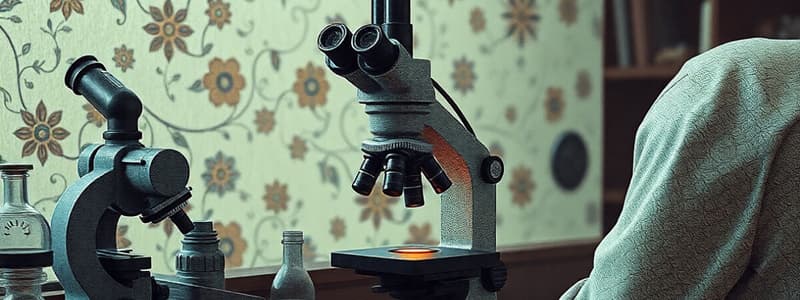Podcast
Questions and Answers
What should be done if the oil-immersion lens appears to contact the stage micrometer during calibration?
What should be done if the oil-immersion lens appears to contact the stage micrometer during calibration?
- Immediately change to a different objective lens.
- Stop, return to the high-dry lens, and complete calibration from there. (correct)
- Adjust the stage micrometer's position to avoid contact.
- Continue with the calibration process without concern.
How should the stage micrometer be positioned when calibrating the ocular micrometer?
How should the stage micrometer be positioned when calibrating the ocular micrometer?
- Position it so that its image is superimposed by the ocular micrometer. (correct)
- It should be positioned randomly on the stage.
- Align it with the right-hand marks of the ocular micrometer.
- It needs to be moved frequently during the calibration process.
What is the purpose of computing average calibrations for each objective lens?
What is the purpose of computing average calibrations for each objective lens?
- To record essential measurements that can be reused without recalibrating. (correct)
- To ensure that the lenses stay clean during use.
- To compare the quality of different objective lenses.
- To allow for quick adjustments during the microscopy.
What should be done when the lines of the stage micrometer are too far apart for direct measurement?
What should be done when the lines of the stage micrometer are too far apart for direct measurement?
What will happen if you change the microscope during the term?
What will happen if you change the microscope during the term?
What property of basic stains allows them to colorize bacterial cells?
What property of basic stains allows them to colorize bacterial cells?
In the staining process, what is the purpose of the squirt bottle with water?
In the staining process, what is the purpose of the squirt bottle with water?
Which of the following organisms is NOT mentioned as a recommended organism for staining?
Which of the following organisms is NOT mentioned as a recommended organism for staining?
What should be used for transferring bacteria if a BSL-2 organism is being handled?
What should be used for transferring bacteria if a BSL-2 organism is being handled?
What type of stain is crystal violet classified as?
What type of stain is crystal violet classified as?
What is the recommended staining time for methylene blue?
What is the recommended staining time for methylene blue?
Which method is specified to reduce aerosol production when heat-fixing a slide?
Which method is specified to reduce aerosol production when heat-fixing a slide?
When preparing a slide with a BSL-2 organism, what should you use to transfer the organism?
When preparing a slide with a BSL-2 organism, what should you use to transfer the organism?
What is the proper technique for observing a slide under the oil-immersion lens?
What is the proper technique for observing a slide under the oil-immersion lens?
What should you do with excess stain while staining slides?
What should you do with excess stain while staining slides?
Why is it recommended to record actual staining times in a data sheet?
Why is it recommended to record actual staining times in a data sheet?
How should you dispose of used slides and stain?
How should you dispose of used slides and stain?
What is the correct approach when applying the stain to the slide?
What is the correct approach when applying the stain to the slide?
What should be done after the slide is stained and before observation?
What should be done after the slide is stained and before observation?
During the heat-fixing process, how long should the slide be held near the microincinerator?
During the heat-fixing process, how long should the slide be held near the microincinerator?
Flashcards are hidden until you start studying
Study Notes
Calibration of Microscopes
- Use a compound microscope with an ocular micrometer for calibration processes.
- Begin with the scanning objective positioned correctly.
- Place a stage micrometer on the stage, aligning its image with the ocular micrometer.
- Record several alignment points between the two micrometers for calibration.
- Switch to the oil-immersion lens; ensure adequate distance to avoid contact with the stage micrometer.
- Average the calibration values for each objective lens and document them for future use without recalibration.
Staining Techniques
- Basic stains contain positively charged chromogens, forming ionic bonds with negatively charged bacterial cells.
- Common basic stains: methylene blue, safranin, and crystal violet.
- For heat-fixing BSL-2 organisms, use a microincinerator to minimize aerosol production.
- Apply stains carefully and avoid excess; let them sit for 30-60 seconds before rinsing.
- Staining observations should document cell morphology, arrangement, and size.
Negative Staining Methodology
- Negative stains utilize negatively charged chromogens that color the background but not the cells, highlighting clear cell outlines.
- This method is crucial for delicate bacteria, such as Treponema, avoiding distortion from heat-fixing.
- Prepare negative stains using nigrosin and eosin, ensuring sterilization of tools after use.
- No heat-fixing is necessary, allowing cellular size and morphology to be assessed accurately.
Laboratory Materials and Safety
- Standard materials for staining procedures include clean glass microscope slides, disposable gloves, chemical eye protection, and specific stains.
- Maintain proper disposal methods for used slides and stains according to laboratory guidelines to ensure safety and cleanliness.
Observations and Record Keeping
- Essential to note down observations during staining procedures, documenting morphology, arrangement, and cellular dimensions for comparison.
- Analyze and compare measurements from negative and simple stains to understand the impact of staining methods on cell appearance.
Questions for Reflection
- Understanding why a negative stain does not colorize the cells is key for grasping staining principles.
- Predicting the outcome of a mixed staining technique (eosin and methylene blue) aids in the understanding of how different chromogens interact with bacterial cells.
- Comparing sizes of different bacteria (e.g., Bacillus cereus, Micrococcus luteus, Rhodospirillum rubrum) assists in learning about species-specific characteristics.
Studying That Suits You
Use AI to generate personalized quizzes and flashcards to suit your learning preferences.




